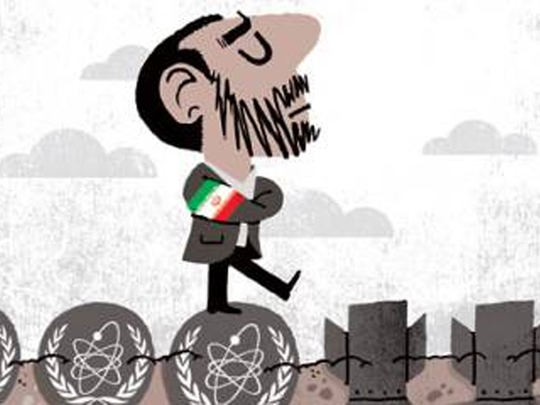
The seventh round of talks over Tehran’s nuclear crisis kicked off on September 18 in New York. Iranian and western diplomats and negotiators have repeatedly acknowledged the existence of a significant gap between Iran and world powers in nuclear talks.
Meanwhile, Iran had committed to taking five steps towards transparency in its nuclear programme by August 25.
However, on September 15, the International Atomic Energy Agency (IAEA) chief, Yukia Amano, said that Iran had addressed only three of the five transparency steps by the deadline.
The three steps that Iran did implement included granting access to the Research and development sites, as well as to assembly workshops and storage facilities.
The two unaddressed issues, the so-called “possible military dimensions” (PMDs) of the country’s atomic programme, concerned alleged experiments on explosives that could be used for an atomic bomb and also studies related to calculating nuclear explosive yields.
One of the IAEA concerns is Iran’s refusal to give the UN agency access to its Parchin military base, southeast of Tehran. The agency is weary of the potential for nuclear-related experiments at that location.
There are two conceivable explanations for these developments. One explanation is that Iran has sought to acquire nuclear weapons. That being the case, it would not be able to address the two remaining issues in a convincing way, nor could it permit IAEA inspectors to visit Parchin and gather environmental samples.
However, in an interview on September 8, Ali Khorram, advisor to the Iranian Foreign Minister Mohammad Javad Zarif, suggested an alternative explanation.
Khorram said: “What happened after the Vienna-6 talks [that ended on July 20] was the submission of maximalist positions [by the West] and revision of the sanctions list by the US. This caused discontent in Iran which affected the process of its cooperation with the IAEA. As a result, out of five [transparency] steps that, according to the agreement with the IAEA, were supposed to be taken [by Iran] no later than August 25, only three were accomplished … as a sign to the West that any agreement should be based on mutual satisfaction.”
When asked how the Parchin dilemma could be resolved, Khorram maintained that the issue could be resolved within the framework of the “final and comprehensive” agreement. “If confidence is built [and a final agreement is reached], Iran has no choice other than to clear up all the ambiguities related to its nuclear programme, including any possible activity at Parchin.”
In other words, Khorram indicated that Iran would consider providing information on the issues with PMDs, as well as allowing IAEA inspectors to visit the Parchin base, provided that the West ceases its side manoeuvres and imposition of pressure. Instead, the West should focus on the realisation of this comprehensive agreement through negotiations.
If Khorram’s latter explanation holds true, that Iran’s failure to address the remaining issues has been symbolic, in protest of the US expanding the sanctions’ list, then convincing Iran to disambiguate the cases seems feasible.
However, if Iran’s contention that these issues are “mere allegations” that do not warrant explanation has emerged because it has indeed performed activities aimed at weaponisation, that could tighten Tehran’s nuclear Gordian knot even further.
Because Iran committed itself to addressing the two suspicious issues last November in its agreement with the IAEA, its choice to now refrain might leave no viable explanation other than its involvement with experiments and research of a nuclear military nature. Such an eventuality could lead to detrimental consequences calling into question Iran’s last 12 years of claims about the peaceful nature of its nuclear programme. Notably, hawks in Washington would gain credibility and significant strength in opposing any deal with Iran that would allow it to continue its uranium enrichment programme. Enriched uranium is a critical component for both civil nuclear power generation and military nuclear weapons.
Meanwhile, the pro-Israel lobby would likely take full advantage of the opportunity created to push both the US administration and the Congress to freeze discussions on the nuclear agreement with Iran, and to intensify pressure on the country with heavier sanctions.
Although the interim nuclear agreement, which was signed between Iran and the world powers last November, does not necessitate the IAEA’s clearance over Iran’s nuclear programme as a pre-condition for final agreement, Iran’s failure to address the IAEA question may affect the nuclear negotiations process.
All in all, if the concerns about the nature of Iran’s nuclear programme are not addressed, a sceptical West may insist on raising the bar too high in its effort to prevent the country from achieving the capability for nuclear ‘breakout’ and building weapon. That will likely widen the already existing gap between Iran and the West even further, with the nuclear talks failing as a consequence.
But optimism is justified and Khorram’s explanation sounds logical. If Iran had conducted military-related nuclear experiments and research, it would not have committed to all five steps towards transparency last November. Any effort not to follow through would surely expose the very crux of western concern.
Shahir ShahidSaless is a political analyst and freelance journalist writing primarily about Iranian domestic and foreign affairs. He is also the co-author of Iran and the United States: An Insider’s View on the Failed Past and the Road to Peace, published in May 2014. He lives in Canada.









